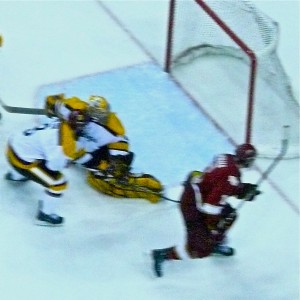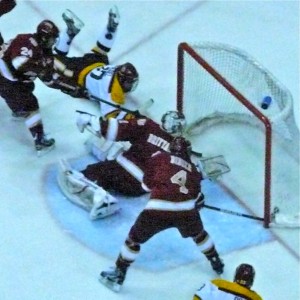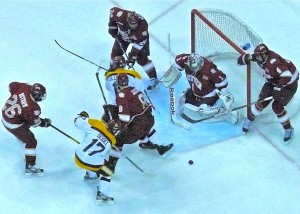Denver blows 3-0 lead, tops UMD in 2 OTs
By John Gilbert
SAINT PAUL, MN. — Zac Larraza is a Denver freshman from Scottsdale, Ariz., whose most prominent role in Friday’s first semifinal at the WCHA Final Five was to serve a major penalty for Denver teammate Larkin Jacobson. Until the second 20-minute overtime, that is. Then, after both teams had played to exhaustion in the longest game in WCHA playoff history, Larraza got on the Xcel Energy Center ice and scored his first collegiate goal to send the Pioneers into the playoff final with a 4-3 victory over Minnesota-Duluth.
The play started as a rush by Denver’s fourth line, and freshman center Matt Tabrum fired a shot from the right side that glanced off the right pipe and out toward the blue line. Defenseman John Ryder shot again.
“Ryder threw it at the net and it hit me in the chest,” said Larraza, who let the puck drop in front of him, pulled it to his right as goaltender Kenny Reiter went down, and then flicked a backhander into the open goal. He did it with the poise and certainty that a veteran scorer might have shown. Instead, Larraza was dressed as Denver’s 13th forward — a spare after the four regular lines.
“That was the biggest goal I’ve scored,” said Larraza. To say nothing of the only one. “I got about 10 shifts in the game, so I was still fresh at the end.”
Officially, the goal came at 8:14 of the second 20-minute overtime, which means it was after 38:14 of sudden-death play, making the game’s duration 98 minutes, 14 seconds, breaking the league playoff record, and leaving 12,804 fans nearly as drained as the players. Another record set in the game was the 67 saves by Denver goaltender Sam Brittain, who withstood UMD’s determined comeback from a 3-0 deficit, which featured the Bulldogs outshooting Denver 70-49.

Goalie Sam Brittain, defenseman Josiah Diddier, and UMD's Mike Seidel watched the bouncing puck's trajectory.
The victory sends Denver (25-12-4) into Saturday’s championship game against the winner of Friday night’s Minnesota-North Dakota second semifinal. UMD goes home 24-9-6, but certain to have a high seed in next week’s NCAA tournament field.
“We dug ourselves a hole at the start, but we did a lot of good things in the second half of the game, and it became a helluva hockey game,” said UMD coach Scott Sandelin. “Both teams had a lot of chances and both goalies made some tremendous saves.”
UMD, which lost a first-round Final Five game to Bemidji State a year ago, before catching a hot streak that went all the way to the NCAA championship on the same Xcel Center ice, had a first-round bye this time as league runner-up, but all that got the Bulldogs was the challenge of playing catch-up against preseason WCHA favorite Denver, the league’s third-place finisher.
As often happens in the Final Five, teams resting with first-game byes don’t always have a big advantage in the semifinals, because during the long season of two-game series, many teams play better in the second game. That theory seemed at work, as Denver, which had to beat Michigan Tech 3-2 in overtime on Thursday to reach Friday’s semifinals, gained the early advantage and built on it during the first period and a half.
The Pioneers led 1-0 on Shawn Ostrow’s first-period goal, when the junior center rushed up the left side 2-on-1 and sent a perfect shot into the upper right corner at 8:01. Denver boosted the lead to 3-0 in the second period, when Jason Zucker scored at 3:26, and at 6:02, Ostrow swung out from behind the net and passed across the crease, where Dustin Jackson shot past Kenny Reiter to score as he was being taken down at the right edge.
The Bulldogs were increasing their tempo by then, however, and when they got a power-play chance midway through the second period, they cracked Sam Brittain’s shutout bid, as Mike Seidel pulled a rebound away from Brittain and deposited it behind him at 10:57.
“That power play turned the tide for them,” said Denver coach George Gwozdecky. “I don’t like to use basketball analogies, but in basketball you hear coaches say they knew the other team would make a run, and in our game, even though we had that 3-0 lead, you knew they were going to make a run.”
Jacked up by the goal, the Bulldogs started firing shots from every angle, and closed in at 3-2 on another Seidel goal, at 13:45. Connolly was absorbing some heavy contact while continuing to work the left boards in the DU zone, and he finally chipped the puck to Seidel in the left circle. Seidel glided across the slot and fired a perfect shot past a screening defenseman and into the upper left corner. UMD went on to outshoot Denver 25-10 in the high-tempo second period, which ended with Seidel swiping a rebound and nearly scoring at the left pipe as the horn sounded. “I thought I had a chance to sneak it in, but the goalie made an unbelievable save with his toe,” Seidel said.
The Bulldogs couldn’t get the equalizer until 12:38 of the third period. Defenseman Drew Olson got the puck from Seidel, who was having an impressive day, and Olson moved left to right toward the slot before sending the puck over to Jack Connolly, a left-handed shooting center who was cranked and ready to rip a one-timer into the upper right corner to knot the game 3-3.
It was Connolly’s 19th goal, to go with 39 assists for the WCHA regular-season scoring champ, who already is a two-time All-America and is a Hobey Baker finalist. Finishing with a flourish, the Bulldogs outshot Denver 17-7 in the third period, making it 42-17 as they came alive for the second and third periods, and 50-24 for all three periods.
“To their credit, they threw everything at the net,” said Brittain, who didn’t play in Thursday’s first game, and who might not play in the final, after his heavy lifting against the Bulldogs.
Regulation time ended ominously for the Bulldogs, however. After working feverishly to come back from a 3-0 deficit, they allowed Zucker to burst through for a final chance. As he turned the corner and cut to his right, Zucker had his feet taken out from under him by a diving Chris Casto. Zucker slid harmlessly past the goal-mouth, but Casto went to the penalty box with 1.3 seconds remaining, which gave Denver a power play overlapping into overtime.
Reiter was brilliant int he 20-minute first overtime, but Brittain matched him as the teams, obviously tiring, played with wide-open offense, Denver outshooting UMD 16-15 as both teams went all-out trying to end the game on the next shift. When the first overtime ended without a goal, Denver had a slim 16-15 edge in shots and the teams went to their dressing rooms still 3-3, and with UMD holding a 65-40 shot margin. But in the second overtime, Denver had a 10-4 edge in shots.
“Our best hockey was in overtime,” Gwozdecky said. “Whatever it takes; it wouldn’t be fun if it wasn’t exciting.”
Comments
Tell me what you're thinking...
and oh, if you want a pic to show with your comment, go get a gravatar!





 John Gilbert is a lifetime Minnesotan and career journalist, specializing in cars and sports during and since spending 30 years at the Minneapolis Tribune, now the Star Tribune. More recently, he has continued translating the high-tech world of autos and sharing his passionate insights as a freelance writer/photographer/broadcaster. A member of the prestigious North American Car and Truck of the Year jury since 1993. John can be heard Monday-Friday from 9-11am on 610 KDAL(www.kdal610.com) on the "John Gilbert Show," and writes a column in the Duluth Reader.
John Gilbert is a lifetime Minnesotan and career journalist, specializing in cars and sports during and since spending 30 years at the Minneapolis Tribune, now the Star Tribune. More recently, he has continued translating the high-tech world of autos and sharing his passionate insights as a freelance writer/photographer/broadcaster. A member of the prestigious North American Car and Truck of the Year jury since 1993. John can be heard Monday-Friday from 9-11am on 610 KDAL(www.kdal610.com) on the "John Gilbert Show," and writes a column in the Duluth Reader.